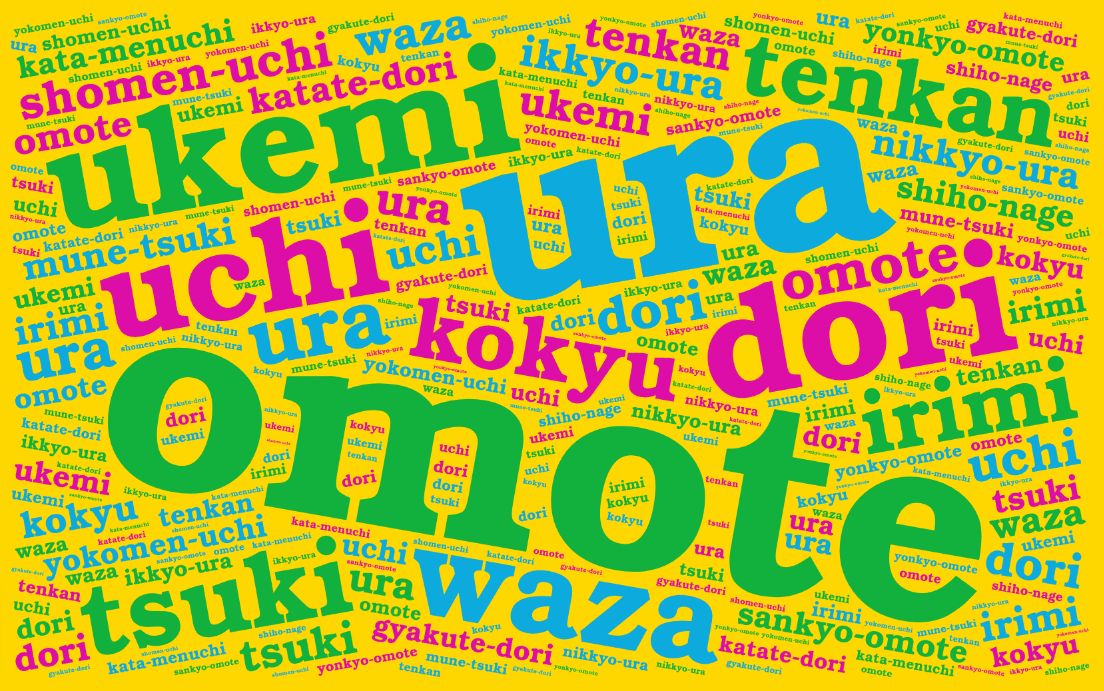This post is meant to help beginning students listen for and understand the technique names we hear in class (especially those on our 6th Kyu exam), and to give those names a little context. “Katate-dori shihonage omote” can sound a little overwhelming if you don’t know how to break it down!
[First, a reminder: Here is an introduction to my Words posts, if you haven’t read it yet.]
Please don’t rely on anything in this post as information about what’s on the test, or about how to do anything. You can find our actual test requirements in the Aikido of San Diego Dojo Handbook. If you train at another dojo, a lot of this may be helpful, but your test will likely not include the same set of techniques, and some dojo have other names for these things. So use this as a starting point for learning to listen for the words used in your own dojo.
At this point I’m going to keep it simple and stick to only what I hear them called in daily training. You will see various spellings and ways of writing these words. I’m using hyphens here to make the parts of the words more obvious (like mune-tsuki), but you will often everything run together (munetsuki).
OK, let’s get started…
Words for Attacks
There are really only three things we do most of the time; we grab, we strike, and we punch. So we have only three core words to deal with. Each one has some additional words we use for specific cases, but basically there are three words for attacks: dori, uchi, and tsuki.
dori
[DOOR-ee]
A grab. We grab lots of things in lots of ways. Straight and cross-hand, grabbing one or both wrists, grabbing with one or both hands, and grabbing from the front, or behind Nage’s back.
Luckily there is only one grab name you need to know for your test, the straight-across (not cross-hand) wrist grab, katate-dori. We’ll do more grab words in another post!
uchi
[OO-chee]
A strike. We have two common kinds of strikes: shomen-uchi, and yokomen-uchi
Shomen-uchi [SHOW-men OO-chee] is a straight strike to the center of the head, at the forehead. Yokomen-uchi [yoh-KOH-men OO-chee] is an angled strike to the side of the head, at the temple or neck. Men means head, sho is center, and yoko means side. In open-hand techniques these strikes are done with the blade edge of the hand. You can also do shomen-uchi and yokomen-uchi with the bokken and jo.
Shomen means the center of the head. You will also hear it in the context of “the shomen,” which is the place at the front-center of the dojo where the picture of O-Sensei is.
tsuki
[tSKEE or SKEE In a complete technique names you will often hear the initial “t” from this word as though it were the last letter of the word preceding it.]
A thrust or punch. Not something you have to know for the 6th kyu exam, but you’ll hear it in class. The punch we do most in class is mune-tsuki [moo-NET-skee], a punch to about the solar plexus, where the ribs and belly meet. Lots of other kinds of punches to leave for later.
A Couple of Ways of Doing Techniques: Front, and Rear
Most techniques have several variations. Some have inside and outside versions. At least one I can think of has four directions (more on that later). Many have a front or rear version. Front is omote, and rear is ura. These are easy to remember because omote/front are longer words, and both have a “t” in them, and ura/rear are shorter, and both have an “r” in them.
Omote
[oh-MOH-tay]
Front. Notice when your partner is standing in hanmi (the basic stance in Aikido) that even though they are facing you their hips and body are oriented more to one side. That’s their front, or omote side. When you do the omote version of a technique you begin by entering to the front side of your partner (more or less).
Ura
[OOR-uh]
Rear. Their backside. The side with the shoulder blades, hindquarters, heels, etc. When you do the ura version of a technique you begin by entering to the rear side of your partner (more or less).
On the 6th kyu test there are two techniques (ikkyo and shihonage) where you will be demonstrating both the omote and ura versions.
Speaking of Ikkyo…
Technique names ending in …kyo [kyoh] are pinning techniques. You’ll hear these names on the mat: ikkyo, nikkyo, sankyo, yonkyo, and gokyo. They are all pinning techniques. If you take off the …kyo part, you end up with roughly counting to 5 in Japanese: ichi, ni, san, yon,* go. (Four is also sometimes “shi.” We’ll get to that.) So they are pinning techniques one through five. Simple, huh? You’ll see the same counting pattern later, in weapons techniques.
The only one on the 6th kyu test is ikkyo (both the omote and ura versions).
Speaking of Shi…
Remember that four is sometimes yon, and sometimes shi. The 6th kyu test includes the technique called shihonage (both the omote and ura versions). Shiho means four-direction and nage means throw.
So, Getting Back to “Katate-dori shihonage omote”
The complete names we use on the mat carry a lot of information, but they really are simple. The patterns is attack (where & how) > technique (description & type) > variation. So katate-dori is the attack, shihonage is the technique, and omote is the variation. Cool, right?
Breaking it down further, we know that dori is one of the three kinds of attacks: a grab. Katate is straight-across to one wrist. So the attack, katate-dori is a one-handed, straight-across grab to the wrist. Awesome. Next?
Shihonage, we know is a throw (nage), and we just learned shiho means four directions. So it’s a four-direction throw (we’ll leave the details of all the directions for another time!). But at least we know it’s a throwing technique. And…
The variation is omote, or front. So the entry for this technique goes to the front of our partner.
Let’s try another one: Shomen-uchi ikkyo ura. Here, you figure it out:
How will your partner attack? Will it be a grab (dori), strike (uchi), or punch (tsuki)?
And where will the attack be directed? At the shomen, right? Remember what that is? By now you should be able to say “my partner is going to attack by _____ing me in the ____.”
So, what kind of technique is this? Ikkyo, sure. So it’s a kind of technique that involves what? It’s not a throw (that would be -nage)… It’s a _____ing technique. And a hint: There are five of them. Which one is this? #_____.
And don’t forget the variation: Ura. So your entry to the technique will be in what direction? “I’ll start by entering to the ______ of my partner.”
Got it?
OK, here’s the whole answer: Shomen-uchi is an attack the front-center of the head. Ikkyo is the first pinning technique. The entry is to the rear of your partner.
Try this with more technique names you hear in class!
A Few More Words to Know
ukemi
[oo-KEH-mee]
Ukemi is what you do when you are Uke [OO-kay]. (The other person is Nage [NAH-gay]. Ukemi includes providing the attack your partner needs so they can practice a technique, and then safely receiving the throw, pin, or whatever they do in response to your attack. The ukemi skills on the 6th kyu exam are forward and backward rolls.
waza
[WAH-zah]
Technique. You will hear this in a lot more contexts, but in day-to-day training we mostly use it for freestyle, or free technique, called jiyu-waza [GEE-yoo WAH-zuh], and for techniques done from the kneeling position (seiza [SAY-zuh]), called suwari-waza [su-WAR-ee WAH-zuh].
tenkan / irimi
[TEN-kahn / ee-REE-mee]
These are the entering and turning movements we do at the beginning of most classes, and they are part of most techniques. Here are some tricks for remembering the words: Tenkan (with a “t”) involves turning (with a “t”). Irimi, at least to me, sounds like “excuse me,” and looks like what you would do if you were sliding past someone in a row of theater seats or a narrow hallway.
kokyu dosa
This is the seated (in seiza) exercise we do at the end of many classes, where your partner grabs your wrists (usually, but not always, both wrists), and you tip them sideways. Kokyu, to the best of my understanding, refers to breath or breathing, and dosa is an exercise (as opposed to a technique).
tai no henko
I’m afraid I’m no help at all on this one, and I forget the words every time I try to describe this. It’s the blending exercise we often do at the start of class, where your partner grabs one wrist (katate-dori again!), and you enter and blend with their energy by stepping and turning (tenkan) alongside them. If you think of a good way to remember the name of this, let me know!
Whew! That seems like a lot for what looks like a very short test, but because it’s all new there’s a lot to learn. I hope this helps you notice and understand these words when you hear them in class.
As always, you can always go back and read all of my Aikido Words posts any time you like (the list will continue to grow).





